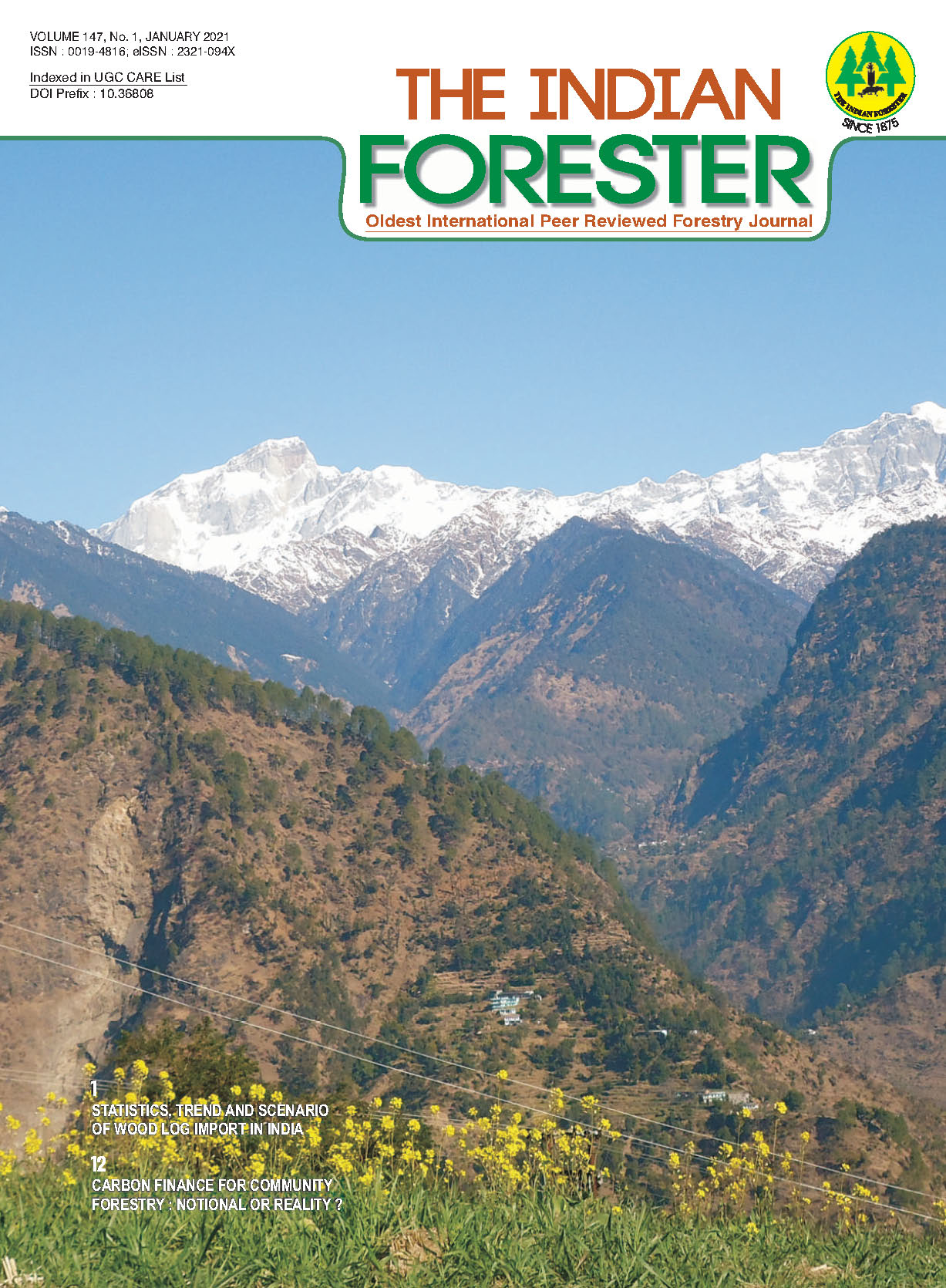Investigation of Phylogenetic Relationships among Some Iranian Rubus L. species
DOI:
https://doi.org/10.36808/if/2021/v147i1/151912Keywords:
Rubus, Phylogeny, ITS, Morphology, Biosystematics.Abstract
Rubus L. is considered as a most complicated genus of Rosaceae that has worldwide distribution. The fruits of some Rubus species are used by human. In current study, authors used morphological and phylogenetic ITS data for taxonomical treatment of 18 Rubus species, which were harvested from northern regions of Iran. Morphological characteristics were subjected for statistical analyses using SPSS and MVSP softwares. For phylogenetic study, DNA was extracted using MBST kit and the results were amplified using ITS primers. Both qualitative and quantitative morphological traits varied among the studied species. Besides, the analysis of variance test revealed significant variations (p ≤ 0.05) for all the quantitative features. The evaluated species were classified into five distinct groups according to morphological characteristics. In ITS phylogenetic cladogram, the evaluated populations were clustered in three distinct clads. Although, species of each clade have some similar morphological traits, the species clustering patterns were not similar in these diagrams. It seems that apomixes, polyploidy and ecological parameters influenced the morphological characteristics and lead to misidentification of Rubus species. This eventually leads to increase in the number of species or synonyms in the genus.References
Alice L.A. and Campbell C.S. (1999). Phylogeny of Rubus (Rosaceae) based on nuclearribosomal DNA internal transcribed spacer region sequences. Am. J. Bot., 86: 81-97.
Ataei-E Jaliseh S., Mehregan I., Tarang A. and Nejadsattari T. (2015). A taxonomic review of Rubus L. (Rosaceae) in the Northern Iran based on the analysis of quantitative morphological characters. Journal of Biodiversity and Environmental Sciences, 6(3): 113- 120.
Boissier E. (1867). Flora Orientalis. H. Georg in Basileae.
Bremer K. (1988). The limits of amino acid sequence data in angiosperm phylogenetic reconstruction. Evolution, 42: 795–803.
Castillo N.R.F., Reed B.M., Graham J., Fernández-Fernández F. and Bassil N.V. (2010). Microsatellite markers for raspberry and blackberry. J. Am. Soc. Hortic. Sci., 135: 271-278.
Dossett M., Bassil N.V., Lewers K.S. and Finn C.E. (2012). Genetic diversity in wild and cultivated black raspberry (Rubus occidentalis L.) evaluated by simple sequence repeat markers. Genet. Resour. Crop Ev., 59: 1849-1865.
Davis P.H. (1972). Rubus, Flora of Turkey and the Aegean Island. Edinburg University Press, Edinburg. 227-244.
Donoghue M.J., Olmstead R.G., Smith J.F. and Palmer J.D. (1992). Phylogenetic relationships of Dipsacales based on rbcL sequences. Ann. Missouri Bot. Gard., 79: 333–345.
Felsenstein J. (1985). Confidence limits on phylogenies: an approach using the bootstrap. Evolution, 39: 783–791.
Finn C.E. and Knight V.H. (2002). What's going on in the world of Rubus breeding? Acta Hortic., 585: 31 -38.
Finn C.E., Swartz H.J., Moore P.P., Ballington J.R. and Kempler C. (2002). Use of 58 Rubus species in five North American breeding programs -breeder's notes. Acta Hortic., 585: 113-119
Focke W.O. (1910). Species Ruborum monographiae generic. Rubi Prodromus. Biblioth. Bot., 17: 1-120.
Focke W.O. (1911). Species Ruborum monographiae generic. Rubi Prodromus. Biblioth. Bot., 17: 121-223.
Focke W.O. (1914). Species Ruborum monographiae generic. Rubi Prodromus. Biblioth. Bot., 17: 1-274.
Gilli A. (1969). Rubus. In: Flora Iranica (Ed. Rechinger, K. H.), 66: 67 75. Akademische Druck-U Verlagsanstalt, Graz.
Graham J., Smith K., MacKenzie K., Jorgenson L., Hackett C. and Powell W. (2004). The construction of a genetic linkage map of red raspberry (Rubus idaeus subsp. idaeus) based on AFLPs, genomic SSR and EST-SSR markers. Theor. Appl. Genet., 109: 740-749.
Graham J., Squire G.R., Marshall B. and Harrison R.E. (1997). Spatially dependent genetic diversity within and between colonies of wild raspberry Rubus idaeus detected using RAPD markers. Mol. Ecol., 6: 1001-1008.
Howarth D.G., Gardner D.E. and Worden C.W. (1997). Phylogeny of Rubus subgenus Idaeobatus (Rosaceae) and its implications toward colonization of the Hawaiian Islands. Syst. Bot., 22(3): 433–41.
Jennings D.L. (1988). Raspberries and blackberries: their breeding, diseases and growth. Academic Press, London.
Komarov V.L. (1971). Rubus, Flora of the. Moscow and Leningrad. U.R.S.S. 6-45.
Khatamsaze M. (1992). Flora of Iran (Rosaceae). Research institute of forests and rangelands, 6: 20-35.
Lee K. J., Lee G.A., Kang H.K., Lee J.R., Raveendar S., Shin M.J., Cho Y.H. and Ma K.H. (2016). Genetic Diversity and Population Structure of Rubus Accessions Using Simple Sequence Repeat Markers. Plant Breed. Biotech., 4(3): 345-351.
Marulanda M., Lopez A.M. and Uribe M. (2012a). Genetic diversity and transferability of Rubus microsatellite markers to South American Rubus species. In: CaliskanM. (ed.). The molecular basis of plant genetic diversity. InTech, Rijeka, Croatia.
Marulanda M., López A.M. and Uribe M. (2012b). Molecular characterization of the Andean blackberry, Rubus glaucus, using SSR markers. Genet. Mol. Res., 11: 322-331.
Meng R. and Finn C.E. (2002). Determining ploidy level and nuclear DNA content in Rubus by flow cytometry. J. Am. Soc.Hortic. Sci., 127: 223-227.
Morden C.W., Gardner D.E. and Weniger D.A. (2003). Phylogeny and biogeography of Pacific Rubus subgenus Idaeobatus (Rosaceae) species: Investigating the origin of the endemic Hawaiian raspberry R. macraei. Pac. Sci., 57(2): 181–97.
Parsa A. (1943) Rubus, Flora de l, Tehran.Iran., 573-576.
Podani J. (2000). Introduction to the Exploration of Multivariate Biological Data. Leiden.
Talebi S.M., Rezakhanlou A. and Matsyura A. (2017a). Do we have infraspecific taxa of Salvia multicaulisVahl. (Lamiaceae) in Iran? Ukr. J. Ecol., 7(4): 432–439.
Talebi S.M., Ghorbani Nahooji M. and Yarmoohammadi M. (2017b). Infra–generic morphological variations in some Nepeta L. taxa of Iran. Ukr. J. Ecol., 7(3): 208–216.
Yang J.Y. and Pak J.H. (2006). Phylogeny of Korean Rubus (Rosaceae) based on ITS (nrDNA) and trnL/F intergenic region (cpDNA). Ukr. J. Ecol., 49(1): 44–54.
Wada S. and Reed B.M. (2008). Morphological Analysis of Rubus Seed. Acta Hortic. DOI: 10.17660/ActaHortic.2008.782.5
Downloads
Downloads
Additional Files
Published
How to Cite
Issue
Section
License
Unless otherwise stated, copyright or similar rights in all materials presented on the site, including graphical images, are owned by Indian Forester.





